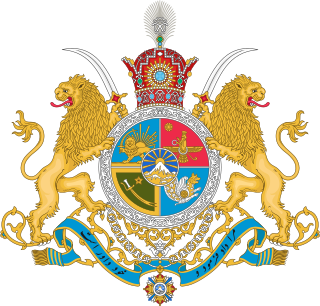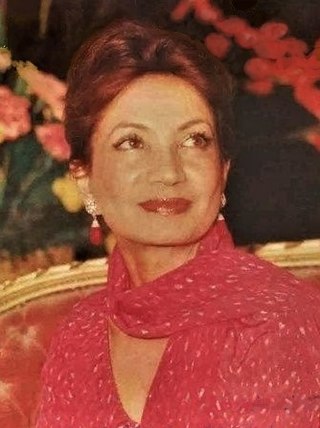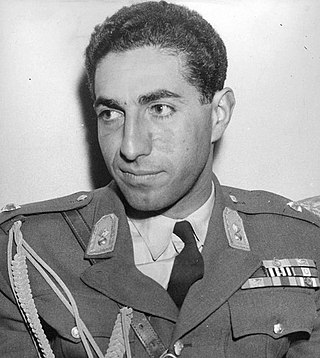
Reza Shah Pahlavi was an Iranian military officer, politician, and first Shah of the House of Pahlavi of the Imperial State of Iran and father of the last Shah of Iran. He reigned from 1925 until he was forced to abdicate after the Anglo-Soviet invasion of Iran in 1941. A modernizer, Reza Shah clashed with the Shia clergy, but also introduced many social, economic, and political reforms during his reign, ultimately laying the foundation of the modern Iranian state. Therefore, he is regarded by many as the founder of modern Iran.

The Pahlavi dynasty was the last Iranian royal dynasty, ruling for almost 54 years between 1925 and 1979. The dynasty was founded by Reza Shah Pahlavi, a non-aristocratic Mazanderani soldier in modern times, who took on the name of the Pahlavi language spoken in the pre-Islamic Sasanian Empire in order to strengthen his nationalist credentials.

Reza Pahlavi, Crown Prince of Iran is the oldest son of Mohammad Reza Pahlavi, the last Shah of Iran, and his wife Farah Diba. Before the Islamic Revolution in 1979, he was the crown prince and the last heir apparent to the throne of the Imperial State of Iran. Today, Pahlavi resides in Great Falls, Virginia.
Reza is the Iranian Persian version of the Arabic name Rida, which literally means "the fact of being pleased or contented; contentment, approval". It is one of the most widely used names in Iran.
Ali Reza Pahlavi was a member of the Pahlavi imperial family of the Imperial State of Iran. He was the younger son of Mohammad Reza Pahlavi, the former Shah of Iran and his third wife Farah Diba. He was second in order of succession to the Iranian throne before the Iranian Revolution.
Ali Reza is a given name popular among Iranians referring to the imams of Shia Islam Ali and Ali al-Ridha.

The Immortal Guard of Imperial Iran, also known as Imperial Guard, was both the personal guard force of Mohammad Reza Pahlavi, the last Shah of Iran, and an elite combat branch of the Imperial Iranian Army. It was created in 1942 and disbanded in 1979 following the Iranian Revolution. It was named after the Immortals, an elite unit of 10,000 Persian soldiers in the army of the Achaemenid Empire.

Mohammad Ali Foroughi, also known as Zoka-ol-Molk, was a writer, diplomat and politician who served three terms as Prime Minister of Iran. He wrote numerous books on ancient Iranian history and is known for founding the Academy of Iran.

Ashraf ol-Molouk Pahlavi was the twin sister of Mohammad Reza Pahlavi, the last Shah of Iran (Persia), and a member of the Pahlavi dynasty. She was considered the "power behind her brother" and was instrumental in the 1953 coup that overthrew Prime Minister Mohammad Mosaddegh in favour of strengthening the monarchical rule of the Shah. She served her brother as a palace adviser and was a strong advocate for women's rights. Following the Iranian Revolution in 1979, she lived in exile in France, New York, Paris and Monte Carlo and remained outspoken against the Iranian Islamic Republic.

Ali Reza Pahlavi was the second son of Reza Shah Pahlavi, Shah of Iran, and the brother of Mohammad Reza Pahlavi. He was a member of the Pahlavi dynasty.

Sepahbod Nader Jahanbani was an Iranian general, distinguished fighter pilot of Imperial Iranian Air Force (IIAF) and the deputy chief of the IIAF under Mohammad Reza Shah Pahlavi, the last Shah of Iran. Despite being executed in 1979 by Islamic Revolutionaries, he is widely lauded as the "father of the Iranian Air Force" along with General Mohammad Khatami and General Amir Hossein Rabii, for modernizing the air force to become a potent and powerful force whose advanced equipment and training they acquired for Iran, such as the F-14 Tomcat, would save Iran's crucial infrastructure during the Iran–Iraq War. He was the leader of the Golden Crown, the first and national aerobatics display Iranian team. He is nicknamed the "blue eyed general of Iran". By many accounts, he is considered one of the best and most capable pilots of his time.

Mohammad Reza Pahlavi, commonly referred to in the Western world as Mohammad Reza Shah, was the last Iranian monarch. He began ruling the Imperial State of Iran after succeeding his father Reza Shah in 1941 and remained in power until he was overthrown by the Iranian Revolution, which abolished the country's monarchy and established the present-day Islamic Republic of Iran in 1979. Owing to his recognition and status as Iran's final monarch, he is usually called the Shah. In 1967, he took up the title Shahanshah and held several others, including Aryamehr and Bozorg Arteshtaran.

Patrick Ali Pahlavi is a member of the deposed Pahlavi dynasty of Iran and was heir presumptive from 1954 to 1960. According to the former constitution of Iran Patrick was the first in the line of succession to the throne. In 1960, however, with the birth of Reza Pahlavi, the latter became the heir apparent. If the Iranian monarchy were to be restored, he would become the heir presumptive to the throne.

The Order of Pahlavi of the Empire of Iran, in Persian: "Neshan-e Pahlavi" was the highest order of the former Imperial State of Iran.

Farah Pahlavi is the widow of the last Shah of Iran, Mohammad Reza Pahlavi, and was successively Queen and Empress of Iran from 1959 to 1979. She was born into a prosperous family whose fortunes were diminished after her father's early death. While studying architecture in Paris, she was introduced to the Shah at the Iranian embassy, and they were married in December 1959. The Shah's first two marriages had not produced a son—necessary for royal succession—resulting in great rejoicing at the birth of Crown Prince Reza in October of the following year. Diba was then free to pursue interests other than domestic duties, though she was not allowed a political role. She worked for many charities, and founded Iran's first American-style university, enabling more women to become students in the country. She also facilitated the buying-back of Iranian antiquities from museums abroad.

Gholam Reza Pahlavi was an Iranian prince and a member of the Pahlavi dynasty, as the son of Reza Shah and half-brother of Mohammad Reza Pahlavi, the last Shah of Iran.

Abdul Reza Pahlavi was a member of Iran's Pahlavi dynasty. He was a son of Reza Shah and a half-brother of Mohammad Reza Pahlavi.

Pahlavi Iran, officially the Imperial State of Persia until 1935 and the Imperial State of Iran thereafter, was the Iranian state between 1925 and 1979, under the rule of the Pahlavi dynasty.














